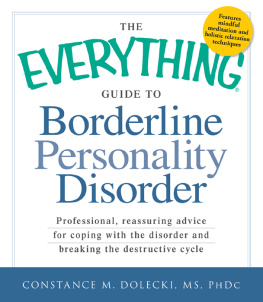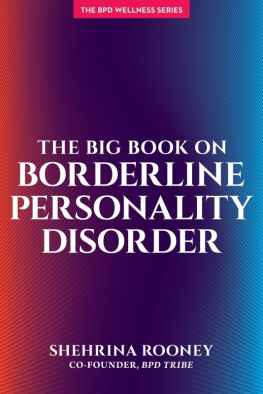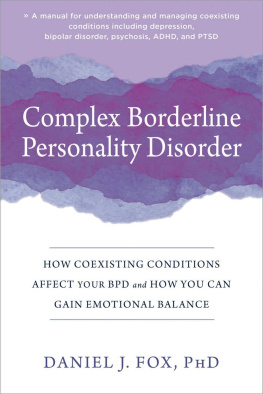BORDERLINE PERSONALITY DISORDER
A JOHNS HOPKINS PRESS HEALTH BOOK
BORDERLINE PERSONALITY DISORDER
 New Reasons for Hope
New Reasons for Hope
Francis Mark
MONDIMORE, M.D.
Patrick
KELLY, M.D.

2011 The Johns Hopkins University Press
All rights reserved. Published 2011
Printed in the United States of America on acid-free paper
9 8 7 6 5 4 3 2 1
The Johns Hopkins University Press
2715 North Charles Street
Baltimore, Maryland 21218-4363
www.press.jhu.edu
LIBRARY OF CONGRESS CATALOGING-IN-PUBLICATION DATA
Mondimore, Francis Mark, 1953
Borderline personality disorder : new reasons for hope /
Francis Mark Mondimore and Patrick Kelly.
p. cm. (a Johns Hopkins Press health book)
Includes bibliographical references and index.
ISBN-13: 978-1-4214-0313-7 (hardcover : alk. paper)
ISBN-10: 1-4214-0313-7 (hardcover : alk. paper)
ISBN-13: 978-1-4214-0314-4 (pbk. : alk. paper)
ISBN-10: 1-4214-0314-5 (pbk.: alk. paper)
1. Borderline personality disorder Popular works. I. Kelly, Patrick, 1978
II. Title.
RC569.5.B67M66 2011
616.85852dc22 2011008903
A catalog record for this book is available from the British Library.
are by Jacqueline Schaffer.
Special discounts are available for bulk purchases of this book. For more information, please contact Special Sales at 410-516-6936 or specialsales@press.jhu.edu.
The Johns Hopkins University Press uses environmentally friendly book materials, including recycled text paper that is composed of at least 30 percent post-consumer waste, whenever possible.
CONTENTS
ACKNOWLEDGMENTS
The authors would like to acknowledge many individuals who contributed to this project with their support and wisdom. First and foremost, thanks to Lynn Stanton, MSW, LCSW, of the Carolinas Healthcare System, whose clinical expertise in the treatment of borderline personality disorder patients was of invaluable help to us in writing every page of this book. Thanks as well to Daniel Buccino, LCSW, Kathleen Evans, MSN, APRN, PMH/BC, and Alice Weisko, Psy.D., and our other colleagues at the Community Psychiatry Program of the Johns Hopkins Bayview Medical Center for their expert feedback on the psychotherapy sections of the book; a more passionate and compassionate group of psychotherapists surely cannot be found anywhere. Thanks to Sina Saidi, M.D., and Chester Schmidt, M.D., for their encouragement during early phases of the project. Any errors are our own.
Thanks to medical illustrator Jacqueline Schaffer for her elegant drawings and to Nelson Donegal, Ph.D., for permission to adapt and use the fMRI image from his important neuroimaging work.
Many thanks to Jacqueline Wehmueller, executive editor for the Johns Hopkins University Press, who first suggested this book; without her patient persuasion and gentle prodding to take on the subject and persevere in its writing, the book simply wouldnt have happened.
F. M.: I would like to thank Joe Craig and Larry Tilson, who graciously allowed me to turn their Blue Ridge Mountain cabin into a writers retreat last summer, and of course, my husband, Jay Rubin, for making sure that I dont take myself too seriously.
P. K.: I would like to thank my family for encouraging me to add what has turned into a wonderful literary journey to an already overfilled schedule. Most of all I would like to thank my husband, Michael Lindsay, for his unwavering patience, support, and encouragement throughout this process.
INTRODUCTION
Individuals who receive a diagnosis of borderline personality disorder have many problems in their emotional lives, in their relationships, and in their behaviors. These problems interact with, exacerbate, and sustain one another. This complexity makes it difficult to know where to start in understanding these individuals better, or how to help them and those who care about them. In this book, we will tease apart this complexity a little at a time to help you grasp these problems better and learn how to be helpful.
If you have been diagnosed with borderline personality disorder, or BPD, we hope that in reading this book, you will understand yourself better, learn how to help your treatment team help you, and begin building healthier relationships and a happier life.
If someone you care about has received a diagnosis of BPD, this book can guide you in understanding the experiences of that person well enough to know how to help and, just as importantly, to learn which problems you will not be able to help with. We also talk about how a person who has BPD gets into treatment.
We believe this book is a good introduction to the diagnosis of BPD for students and beginning mental health professionals. For these readers, we have provided an appendix that offers a fuller discussion of more advanced theoretical and technical matters.
We also wrote this book to share with you that there are new reasons to hope! In only the past ten years, several large, comprehensive research projects have studied groups of individuals with a diagnosis of BPD over many years. These research projects were the first of their kind and have contributed enormously to the current state of knowledge. One of the first research papers to report on these studies, published in 2005, came to what at the time was a quite startling conclusion:
After careful analysis of the first six years of [this study, it was found] that remissions [patient getting completely better] are far more common than previously recognized These remissions are quite stable and thus, recurrences are quite rare It was also found that borderline patients were improving [in their relationships] over time [and that the] functioning of remitted patients continued to improve as time progressed. Taken together, these results suggest that the prognosis for BPD is better than previously recognized [emphasis added].
Borderline personality disorder is a psychiatric diagnosis that has been difficult to comprehend almost since it was first described in the late 1930s. As the decades have gone by, it has continued to be controversial. Experts still disagree on how to define it, diagnose it, and best treat those who have BPD. One expert described persons who have borderline personality disorder as the psychological equivalent of third degree burn patients. This apt description captures how impaired and fragile these individuals often are, how difficult it can be to fully grasp the complexity and range of their problems, and how challenging it can be to successfully treat them. Many introductory books about this diagnosis, and most books for general readers, skirt these complexities and uncertainties. They confidently quote the diagnostic criteria of the DSM (the American Psychiatric Associations Diagnostic and Statistical Manual of Mental Disorders) in an attempt to provide simple and straightforward answers to questions about borderline personality. This is not such a book.
We recommend that you set aside any idea that you will be able to breeze through this book in an evening or two and come away with a full understanding of this diagnosis and its treatment. There is an old adage that goes something like this: Every complex question has a simple answerand its always wrong. We believe that this applies more to borderline personality disorder than to any other psychiatric diagnosis.
Therefore, in writing this book, we have decided that were not going to take any shortcuts, that we wont avoid what may seem like merely theoretical discussions if they are important to understanding these problems better. We will dive into the scientific literature feet first and explain its implications (providing complete scholarly references for those who feel up to wrestling with the original research papers as well).
Next page







 New Reasons for Hope
New Reasons for Hope